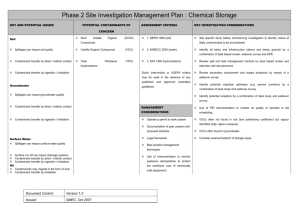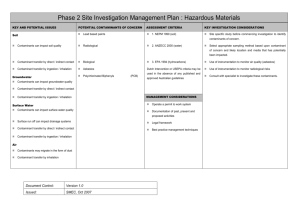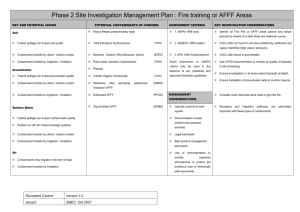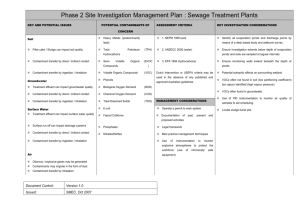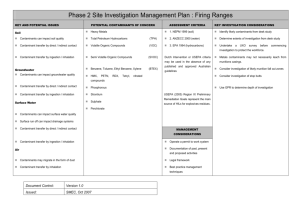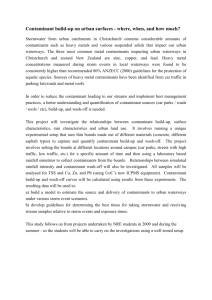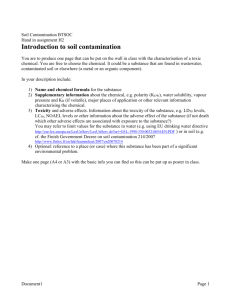A General Chemistry Assignment Analyzing Environmental
advertisement
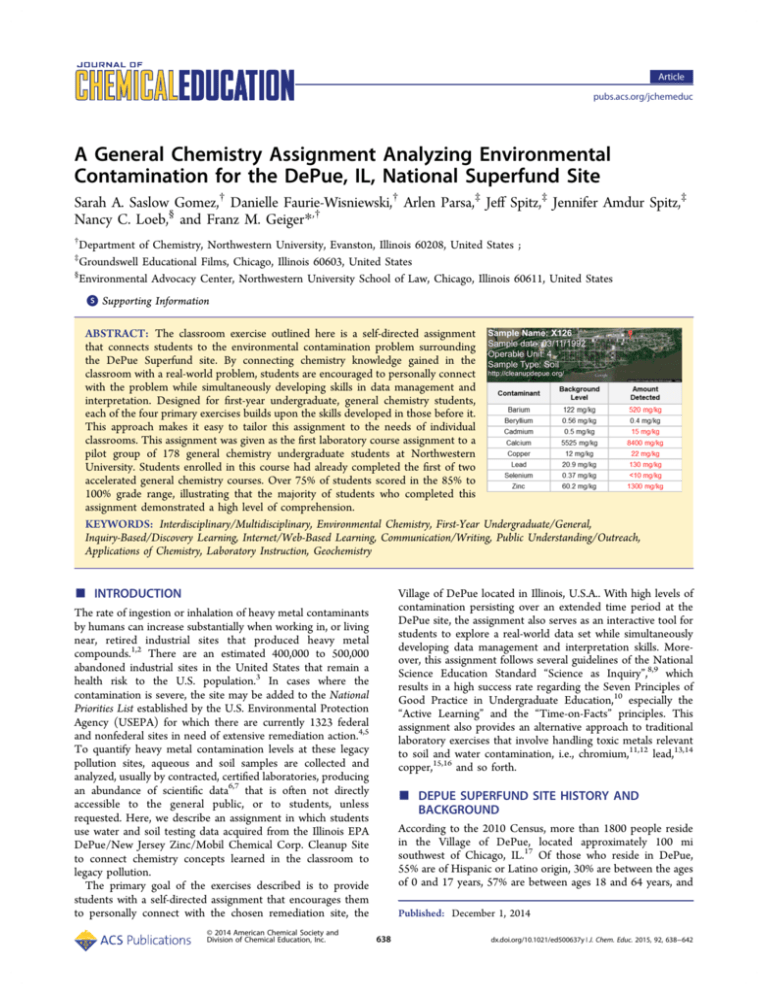
Article pubs.acs.org/jchemeduc A General Chemistry Assignment Analyzing Environmental Contamination for the DePue, IL, National Superfund Site Sarah A. Saslow Gomez,† Danielle Faurie-Wisniewski,† Arlen Parsa,‡ Jeff Spitz,‡ Jennifer Amdur Spitz,‡ Nancy C. Loeb,§ and Franz M. Geiger*,† † Department of Chemistry, Northwestern University, Evanston, Illinois 60208, United States ; Groundswell Educational Films, Chicago, Illinois 60603, United States § Environmental Advocacy Center, Northwestern University School of Law, Chicago, Illinois 60611, United States ‡ S Supporting Information * ABSTRACT: The classroom exercise outlined here is a self-directed assignment that connects students to the environmental contamination problem surrounding the DePue Superfund site. By connecting chemistry knowledge gained in the classroom with a real-world problem, students are encouraged to personally connect with the problem while simultaneously developing skills in data management and interpretation. Designed for first-year undergraduate, general chemistry students, each of the four primary exercises builds upon the skills developed in those before it. This approach makes it easy to tailor this assignment to the needs of individual classrooms. This assignment was given as the first laboratory course assignment to a pilot group of 178 general chemistry undergraduate students at Northwestern University. Students enrolled in this course had already completed the first of two accelerated general chemistry courses. Over 75% of students scored in the 85% to 100% grade range, illustrating that the majority of students who completed this assignment demonstrated a high level of comprehension. KEYWORDS: Interdisciplinary/Multidisciplinary, Environmental Chemistry, First-Year Undergraduate/General, Inquiry-Based/Discovery Learning, Internet/Web-Based Learning, Communication/Writing, Public Understanding/Outreach, Applications of Chemistry, Laboratory Instruction, Geochemistry ■ INTRODUCTION The rate of ingestion or inhalation of heavy metal contaminants by humans can increase substantially when working in, or living near, retired industrial sites that produced heavy metal compounds.1,2 There are an estimated 400,000 to 500,000 abandoned industrial sites in the United States that remain a health risk to the U.S. population.3 In cases where the contamination is severe, the site may be added to the National Priorities List established by the U.S. Environmental Protection Agency (USEPA) for which there are currently 1323 federal and nonfederal sites in need of extensive remediation action.4,5 To quantify heavy metal contamination levels at these legacy pollution sites, aqueous and soil samples are collected and analyzed, usually by contracted, certified laboratories, producing an abundance of scientific data6,7 that is often not directly accessible to the general public, or to students, unless requested. Here, we describe an assignment in which students use water and soil testing data acquired from the Illinois EPA DePue/New Jersey Zinc/Mobil Chemical Corp. Cleanup Site to connect chemistry concepts learned in the classroom to legacy pollution. The primary goal of the exercises described is to provide students with a self-directed assignment that encourages them to personally connect with the chosen remediation site, the © 2014 American Chemical Society and Division of Chemical Education, Inc. Village of DePue located in Illinois, U.S.A.. With high levels of contamination persisting over an extended time period at the DePue site, the assignment also serves as an interactive tool for students to explore a real-world data set while simultaneously developing data management and interpretation skills. Moreover, this assignment follows several guidelines of the National Science Education Standard “Science as Inquiry”,8,9 which results in a high success rate regarding the Seven Principles of Good Practice in Undergraduate Education,10 especially the “Active Learning” and the “Time-on-Facts” principles. This assignment also provides an alternative approach to traditional laboratory exercises that involve handling toxic metals relevant to soil and water contamination, i.e., chromium,11,12 lead,13,14 copper,15,16 and so forth. ■ DEPUE SUPERFUND SITE HISTORY AND BACKGROUND According to the 2010 Census, more than 1800 people reside in the Village of DePue, located approximately 100 mi southwest of Chicago, IL.17 Of those who reside in DePue, 55% are of Hispanic or Latino origin, 30% are between the ages of 0 and 17 years, 57% are between ages 18 and 64 years, and Published: December 1, 2014 638 dx.doi.org/10.1021/ed500637y | J. Chem. Educ. 2015, 92, 638−642 Journal of Chemical Education Article only 13% of residents are 65 years old or older.17 Covering approximately 3 mi2,17 the Village of DePue was added to the National Priorities List in 1999, making it what is otherwise known as a “Superfund” site,18 and targeted for cleanup under U.S. law enacted by the 96th U.S. Congress.19 DePue’s contamination legacy began with zinc smelting and sulfuric acid operations conducted on-site by the New Jersey Zinc Company from 1903 to 1967, followed by, among other products, the production of diammonium phosphate (DAP) fertilizer.18 Mobil Chemical Corporation (currently ExxonMobil) began leasing the DAP and sulfuric acid plants in 1972 until formally purchased from New Jersey Zinc Co. in 1975.18 In 1987 all industrial operations ceased and the plants were demolished in 1991. As a result of a succession of mergers and acquisitions, CBS Operations, Viacom and ExxonMobil are the responsible parties and are charged with the task of remediating the site. The most noticeable evidence of contamination is the estimated 65 ft high and quarter mile long, uncovered slag pile lining the edge of the old plant site. It is estimated that this slag pile contains over 750,000 tons of waste slag contaminated with zinc and other metal contaminants.18 The DePue Superfund site has been broken into five so-called operable units with the idea that tailored remediation efforts can be developed to address the specific needs of each unit. We obtained data on contaminant concentrations for all operable units from the Illinois EPA (IEPA) to construct an interactive “Cleanup DePue” contamination map20 that forms the basis for the majority of the described activities. The map provides the location of each water and soil sample, and concentrations therein, of over 30 different contaminants collected from 1996 to 2011.20 Of the 768 water samples collected in this 15-year period, 739, or 96%, exceed the USEPA maximum contaminant level (MCL) for drinking water for at least one of the contaminants tested. A total of 1191 of the 1208, or 98.6%, soil samples collected exceed at least one of the IEPA soil background contaminant levels (SBCL). Please note that while drinking water MCL regulations were used for the quantitative analysis of water sample data, the Village wells that supply residents with drinking water are compliant with Safe Drinking Water Act standards. Preliminary Exercise: DePue Background and Web Site Familiarization To prepare students for the assignment, students are asked to visit cleanupdepue.org and learn about the village’s history, its struggle as a nationally recognized Superfund site, and the efforts being made to clean up the Village of DePue. Students are also asked to explore and become familiar with the DePue, Illinois Contamination Map (http://cleanupdepue.org/ contamination-map/).20 The interactive map provides visual markers for the samples collected and summarized in the large data sets that students will analyze. After familiarizing themselves with the DePue Web site, students should possess a general understanding of what scientific data is provided by the map, the scientific meaning of “maximum contaminant level” and “soil background contaminant level”, and the difference between primary and secondary contaminants. Exercise 1: Identifying and Understanding Sample Specific Information The purpose of this first exercise is for the students to demonstrate their understanding of the scientific information provided for each sample. Students are tasked with choosing one sample (soil or water) from the contamination map and recording its name, geographic location, and key characteristics, i.e., sample type, sample depth, and general sample location. The students are then asked to construct a table that organizes the raw information by contaminant (Cr, Pb, etc.), the corresponding concentration for each contaminant, each contaminant’s MCL (water) or SBCL (soil), and its associated health effects. Using their tabulated data, the students are then asked to identify which contaminants exceed their corresponding MCL or SBCL and calculate by what percent the MCL or SBCL is exceeded. A sample calculation should be included in the final report for evaluation and assessment. Exercise 2: Downloading and Handling Large Data Sets and Extracting Specific Information The objective of the second exercise is to introduce students to large data sets, exceeding tens of thousands of entries that can still be handled readily by Excel, and to develop the skills necessary for efficiently extracting the desired information from them. To complete this exercise, students are required to download the two Excel data files for all soil and all water and groundwater samples. These files may be found online above the contaminant map.20 Once these files have been downloaded, students should create working files on their own hard drives in order to maintain the integrity of the source file. For the data analysis portion of this exercise, students analyze data from the soil and water/groundwater samples separately due to the different definitions of the MCL for water and SBCL for soil samples. Before sorting through their data sets, each student should choose six contaminants and list these in their report. For each of the six contaminants, the students are tasked with finding the sample that contains the highest contaminant concentration above the MCL or SBCL ((M/SB)CL). Note that the term MCL is used to denote SBCL within the soil samples data file. This task is easily accomplished by dividing the recorded contaminant concentration by the contaminant (M/SB)CL and using the “Sort” function in Excel to identify the sample with the highest ratio. After isolating one sample containing the highest concentration to (M/SB)CL ratio for each of the six contaminants, the students should identify the contaminant and sample with the highest ratio. At the end of this exercise, students will have identified and recorded the ■ ASSIGNMENT OVERVIEW The goal of this general chemistry assignment is to develop students’ research and analytical skills through exercises designed to teach (i) how to locate and obtain quantitative scientific data from Internet sources; (ii) how to organize, understand, and work with large scientific data sets; (iii) how to identify data correlations; and (vi) how to scientifically analyze an important environmental problem in the U.S. Moreover, the real-world environmental contamination data used in this activity connects students with a local community directly affected by legacy pollution. At Northwestern University, undergraduates completed the assignment during the first (lab check-in) week of the second quarter of the General Chemistry sequence when there was no experimental laboratory activity scheduled. Students were instructed to work in pairs; however, each student submitted their own report. The bulk of this assignment was designed to be completed in a 3-h long period with additional time required to complete the preliminary exercise (∼20 min) and write the final report. All data required to complete this assignment may be found online.21 639 dx.doi.org/10.1021/ed500637y | J. Chem. Educ. 2015, 92, 638−642 Journal of Chemical Education Article of interest. On the basis of their analysis, students should discuss in their report which contaminants they would flag as “of concern”, meaning if that contaminant were detected in a water or soil source then one would predict a high likelihood of finding those additional contaminants that exhibit a correlation parameter as identified in the students’ analysis. An explanation of chosen correlation parameters should also be explicitly stated in their report. name, operable unit, and location of one soil and one water sample, the name of the contaminant with the highest concentration to (M/SB)CL ratio for both the soil and water samples, and the associated concentration/(M/SB)CL ratio value. Exercise 3: Identifying and Communicating Trends in Environmental Contamination through Scientific Graphs To determine whether correlations among elevated contaminant concentrations exist, students create graphs and quantify the correlation using a linear least-squares fit analysis. From the six contaminants chosen in exercise two, students should select one (primary) contaminant to which they will compare the remaining five (secondary) contaminants. Prior to completing this analysis, students should hypothesize any correlations between contaminants and provide a rationale for their hypothesis. If needed, some help may be provided to the students in terms of suggesting they think about basic chemical principles taught in General Chemistry, such as the solubility product or the activity series. After formulating their hypothesis, students are tasked to display their findings in graphs that plot the sample concentrations of their five secondary contaminants versus the sample concentrations of their primary contaminant. A sample graph is provided in Figure 1. Exercise 4: Community Risk Evaluation This final exercise was designed to provide students with an idea of how much contamination the residents, specifically school-age residents, of the Village of DePue are exposed to daily and over their years in primary and secondary education. After familiarizing themselves with census data about the community, students are asked to use Google Maps to locate the DePue Unit School and trace a reasonably short path along roads that a 12th grade student would take from their home, arbitrarily selected by the student, to school. After printing this map, students should identify the soil sample locations within two blocks of that path, recording the names of the soil samples in their report and on the map itself. For each of the soil samples identified, students record the highest concentration to SBCL ratio at each soil sample location. In some cases data has been taken at different depths at the same location: in such cases students should be sure to select the sample that is closest to the Earth’s surface. Then, assuming that the DePue 12th grader collects 10 mg of soil on the bottom of his or her shoes from each site they pass, the student estimates the amount of the most abundant contaminant collected (in micrograms) at each site. Figure 2 depicts the hypothetical path from home to school of a 12th grader passing the vicinity of sample OU4-SS-13-COMP1(612), for which the highest concentration to SBCL ratio was determined for cadmium, with 44.7 mg Cd/kg soil recorded. The estimated amount of Cd collected on the 12th grader’s shoes as they passed this site was calculated to be 0.450 μg, according to the following calculation, 44.7 mg 1 kg 10 mg 1 × 103 μg · · · kg 1 mg 1 × 106 mg pair of shoes = 0.450 μg Cd per pair of shoes Figure 1. A sample plot illustrating the correlation between beryllium and aluminum concentration for soil samples collected at the DePue, IL Superfund site. A linear least-squares fit, y = a + bx (red line), was used to obtain the intercept (a) and the slope (b) of the line and quantify the correlation according to the uncertainty associated with the slope. (1) Students should include a sample of this calculation in their report and provide a list or table recording (a) the soil samples to which their hypothetical 12th grade student is exposed to and (b) the amount of contaminant (in micrograms) present on his or her shoes for the associated highest concentration to SBCL contaminant determined for that sample. The same contaminant may be identified as having the highest concentration to SBCL ratio at multiple sites. To expand on the knowledge students have now acquired from the census and contamination data for the Village of DePue, the next task is to estimate (within an order of magnitude) how many milligrams of the contaminants identified in the first part of this exercise are brought into the school each day, assuming that all kids between the ages of 5 and 18 attend the DePue Unit School. Next, students should research the number of school days for the current calendar school year. The students are then asked to compute the amount (in grams) of each contaminant accumulated at the school over the past 14 years, assuming that regular cleaning procedures at the school are inadequate for removing the Once the students have created their contaminant concentration plots, a linear least-square fit expression is used to determine the correlation between the compared contaminants. Students should take note of these fit parameters, along with the associated confidence intervals of the point estimates, and identify whether secondary contaminants are strongly or weakly correlated with the primary contaminant (as a point of example, aluminum in soil is often found in this analysis to be associated with beryllium, as shown in Figure 1). Students should also judiciously choose a cutoff value for the uncertainty associated with the slope that indicates a positive or negative correlation. In the sample report provided in the Supporting Information, uncertainties exceeding 10% of the reported b value indicate no correlation between the secondary and primary contaminants 640 dx.doi.org/10.1021/ed500637y | J. Chem. Educ. 2015, 92, 638−642 Journal of Chemical Education Article Figure 2. A sample walking route (red line) for a 12th grade student walking from their home to the DePue Unit School. Contaminants with the highest concentration to MCL ratio were identified for samples within a two block of the walking route, outlined in black. No alterations were made to the Google map used in this figure; the overlaid black and red lines, red arrow, and white “U4-SS-13-COMP1(6-12)” label were added using Microsoft PowerPoint. contaminants from the school’s floors. This amount represents an estimate of the maximum contamination to which the village’s students would be exposed to over the course of their primary education, provided the assumptions of the estimation calculation are valid and without accounting for actual ingestion or exposure durations. Students should summarize their findings, including a discussion of the validity of the assumption made in the estimation, in the discussion section of their report. ■ ■ HAZARDS There are no hazards associated with this assignment/ laboratory. STUDENT COMPREHENSION AND PERFORMANCE The DePue assignment was given to 178 undergraduate students enrolled in the second of two accelerated general chemistry courses. The students’ reports were graded based on exercise completion, interpretation of their results, and compliance to report format by one of nine teaching assistants (TAs) according to the guidelines detailed in the Supporting Information and summarized below. A grade distribution, shown in Figure 3, illustrates that the majority of students who completed this assignment demonstrated a high level of comprehension. Students’ ability to locate and understand the data provided for a single, selected sample (Exercise 1) was assessed based on reported sample details, successful compilation of a table summarizing contaminant data, and a sample calculation for determining by how many percent a contaminant concentration exceeds the (M/SB)CL. In Exercise 2, the students were evaluated on their ability to handle, interpret, and extract information from large data sets. Students who successfully completed this exercise reported the highest measured contaminant, selected from a set of 6 student-chosen contaminants, for the soil and water data sets. Students Figure 3. The grade distribution for this assignment illustrates the students’ comprehension and ability to complete the tasks assigned. The DePue assignment was given to a class of 178 undergraduate students enrolled in their second general chemistry course. This course is part of a two course accelerated general chemistry series. specifically included in their report the contaminant, contaminant concentration, sample name, (M/SB)CL, and the calculated concentration to (M/SB)CL ratio for the water sample and soil sample associated with the highest measured contaminant. For Exercise 3, student comprehension was assessed in three areas; hypothesis formation and justification, graph compilation and data analysis, and identifying contaminants of concern according to a detailed selection or cutoff procedure decided by the student. Students that successfully completed Exercise 4 included a summary of the Census Bureau data for the Village of DePue, a map detailing the path their DePue student walked to school, a summary of the soil samples within two blocks of the DePue student’s path, sample calculations for daily and annual amount of contaminants brought into the school by that student, a calculation for the 641 dx.doi.org/10.1021/ed500637y | J. Chem. Educ. 2015, 92, 638−642 Journal of Chemical Education Article of the Division of Chemistry of the NSF under Grant No. 0950433 is gratefully acknowledged. total contaminant accumulation over the student’s tenure at the DePue school, and summarized their findings. Finally, discretionary points for units, significant figures, and citations were awarded at the discretion of the TA. ■ ■ (1) Järup, L. Hazards of Heavy Metal Contamination. Br. Med. Bull. 2003, 68, 167−182. (2) Pruvot, C.; Douay, F.; Hervé, F.; Waterlot, C. Heavy Metals in Soil, Crops and Grass as a Source of Human Exposure in the Former Mining Areas. J. Soils Sediments 2006, 6, 215−220. (3) Albanese, S.; Cicchella, D. Legacy Problems in Urban Geochemistry. Elements 2012, 8, 423−428. (4) U.S. Environmental Protection Agency. National Priorities List (NPL); U.S. Environmental Protection Agency. http://www.epa.gov/ superfund/sites/npl/ (accessed Nov 2014). (5) Baird, C. Environmental Chemistry; W. H. Freeman and Co.: New York, NY, 1999. (6) Alloway, B. J. Heavy Metals in Soils, 3rd ed.; Springer: London, U.K., 1995. (7) Boulding, J. R.; Ginn, J. S. Practical Handbook of Soil, Vadose Zone, and Ground-Water Contamination: Assessment, Prevention, and Remediation; CRC Press: Boca Raton, FL, 2003. (8) Morrow, C. A. What Are the Similarities between Scientific Research and Science Education Reform?; Space Science Institute: Boulder, CO, 2000. (9) Council, N. R. National Science Education Standards; National Academy Press: Washington DC, 1996. (10) Chickering, A. W.; Gamson, Z. F. 7 Principles for Good Practice in Undergraduate Education. Biochem. Educ. 1989, 17, 140−141. (11) Todebush, P. M.; Geiger, F. M. Sedimentation Time Measurements of Soil Particles by Light Scattering and Determination of Chromium, Lead, and Iron in Soil Samples via Icp. J. Chem. Educ. 2005, 82, 1542. (12) Sadik, O. A.; Noah, N. M.; Okello, V. A.; Sun, Z. Catalytic Reduction of Hexavalent Chromium Using Palladium Nanoparticles: An Undergraduate Nanotechnology Laboratory. J. Chem. Educ. 2013, 91, 269−273. (13) Roundhill, D. M. Novel Strategies for the Removal of Toxic Metals from Soils and Waters. J. Chem. Educ. 2004, 81, 275. (14) Adami, G. A New Project-Based Lab for Undergraduate Environmental and Analytical Chemistry. J. Chem. Educ. 2006, 83, 253. (15) Bowden, J. A.; Nocito, B. A.; Lowers, R. H.; Guillette, L. J.; Williams, K. R.; Young, V. Y. Environmental Indicators of Metal Pollution and Emission: An Experiment for the Instrumental Analysis Laboratory. J. Chem. Educ. 2012, 89, 1057−1060. (16) Elsayed-Ali, A. H.; Abdel-Fattah, T.; Elsayed-Ali, H. E. Laboratory Experiment on Electrokinetic Remediation of Soil. J. Chem. Educ. 2011, 88, 1126−1129. (17) U.S. Census Bureau. 2010 Census; U.S. Census Bureau.http:// www.census.gov/2010census/ (accessed Nov 2014). (18) Illinois Environmental Protection Agency; Depue/New Jersey Zinc/Mobil Chemical Corp.; Illinois Environmental Protection Agency. http://www.epa.state.il.us/community-relations/fact-sheets/newjersey-zinc/index.html (accessed Nov 2014). (19) U.S. Congress. Comprehensive Environmental Response, Compensation and Liability Act of 1980. Public Law 1980, 96−510. (20) Parsa, A. Depue, Illinois Contamination Map; Groundswell Educational Films. http://cleanupdepue.org/contamination-map/ (accessed Nov 2014). (21) Parsa, A. Cleanup DePue; Groundswell Educational Films. http://cleanupdepue.org/ (accessed Nov 2014). SUMMARY In this assignment, students are introduced to the ongoing environmental remediation investigation for the Village of DePue, a USEPA-listed Superfund site. Designed to connect students to a real environmental issue and the scientific data influencing the remediation process, this activity provides a level of self-design that encourages students to explore and pursue specific contaminants of interest to them. Furthermore, while completing the assigned exercises students will develop valuable skills in handling and analyzing large data sets, drawing impactful conclusions from their analysis, and presenting their results in a way that is clear and impactful. As evident from the grade distribution for 178 undergraduate students who completed this assignment, this assignment is recommended for upper-level high school students and undergraduates enrolled in introductory chemistry courses. The components of this assignment build on the skills and knowledge obtained by completing the sections prior and should be considered when shortening or adapting this assignment for individual classrooms. To reduce assignment difficulty and/or time requirement without removing entire exercises, a specific contaminant(s) can be assigned in exercises 2 and 3, or in exercise 4, the soil samples reported can be limited to a one block radius or a specific number of samples, i.e., 5 samples. In circumstances where this assignment needs to be more challenging, the number of considered contaminants in exercises 2 and 3 could be expanded. Additional suggestions for tailoring this assignment to particular topics and skills addressed in general chemistry are also provided in the Supporting Information. Finally, the grading rubric provided in the Supporting Information is meant to serve as a guide and the point distribution has been omitted to encourage tailored point assignments that will stress the development of specific skill development. ■ ASSOCIATED CONTENT S Supporting Information * Instructions, grading guidelines, a sample report, and suggested assignment adaptations are provided. This material is available via the Internet at http://pubs.acs.org. ■ REFERENCES AUTHOR INFORMATION Corresponding Author *E-mail: geigerf@chem.northwestern.edu. Notes The authors declare no competing financial interest. ■ ACKNOWLEDGMENTS We gratefully acknowledge the people of the Village of DePue and the reviewers of this manuscript for their valuable suggestions. S.A.S.G. and D.F.W. gratefully acknowledge support from the Graduate Research Fellowship Program (GRFP) of the National Science Foundation (NSF). Funding from the Initiative for Sustainability and Energy at Northwestern (ISEN) and the Environmental Chemical Sciences Program 642 dx.doi.org/10.1021/ed500637y | J. Chem. Educ. 2015, 92, 638−642

